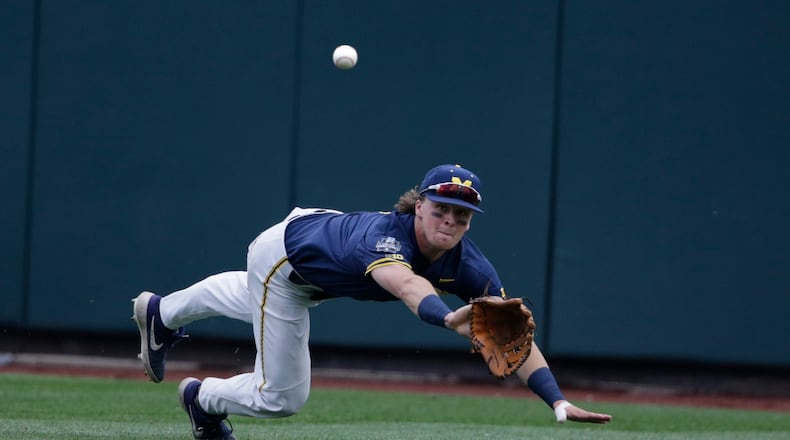The Braves selected Michigan outfielder Jesse Franklin with their third rounder, No. 97 overall, in the 2020 MLB draft Thursday evening. They followed with Clemson right-hander Spencer Strider in the fourth round (No. 126) and Texas righty Bryce Elder in the fifth.
Including first rounder Jared Shuster, the Braves’ class comprised of four college talents, three of whom were pitchers. That completed the five-round draft, which was 35 sessions shorter than usual.
“In 31 years in baseball, I’ve never seen anything like it,” Braves vice president of scouting Dana Brown said. “I started scouting in 1993. I’ve been in a lot of draft rooms. It’s difficult, challenging, but a good part of it is you have to trust your earlier looks on players from the summer and trust the data.”
The Braves began night 2 with their lone position player at No. 97. Franklin didn’t play in the shortened 2020 season because of a collarbone injury. He hit .327/.379/.588 across 47 games as a freshman and .262/.388/.477 in 68 games as a sophomore. He increased his home run (10 to 13) and RBI (47 to 55) totals in those seasons.
A Seattle native, Franklin was drafted by his hometown Mariners in the 2017 draft, but opted for the Wolverines. He’s 6-foot-1, 215 pounds and well-regarded for his potential power-speed combination. He’s the definition of a “toolsy” player, as they say in draft lingo.
“We like the makeup, the strength, the body, the swing,” Brown said. “He’ll grow into some power. I saw it more so in batting practice, so he’s got some raw power. Because of the swing and the way it looks, we feel like he’ll be able to get into a lot of that power.”
Franklin broke his collarbone in a skiing crash outside Seattle in January. He was targeting an April return, but the pandemic prematurely ended the college season.
Baseball America graded Franklin its 151st overall prospect, labeling him a player highly likely to make the majors because of his base talent and work ethic.
He was among the many prospects affected by the season's cancellation, telling the Detroit Free Press last month: "I wasn't able to prove to the scouts that I've gotten any better."
While the skiing incident was a freak injury, it wasn’t the only one that’s struck Franklin. He had shoulder issues as a senior in high school, requiring surgery on his torn labrum. He had to play some first base when he arrived at Michigan as he was still recovering, but rebounded enough to lead the team in homers, slugging and RBIs.
Franklin moved to the outfield as a sophomore. He was drafted as a center fielder, and his viability there long term will be determined in how much he grows physically, Brown said.
Strider, meanwhile, missed the 2019 season after undergoing elbow surgery. The draft eligible sophomore came off the board at pick 126.
The 6-foot, 195-pound righty was a freshman All-America (Collegiate Baseball). He had a 4.76 ERA across 22 appearances (six starts) while striking out 70 and holding opponents to a .215 average over 51 innings. He posted 12.35 strikeouts per nine innings, the fourth-best mark in school history.
He was especially effective as a reliever, posting a 2.59 ERA in 16 appearances. He lowered that number to 2.14 in conference play (nine appearances). The Braves still consider him a starter.
Strider suffered a torn UCL while warming up in January, 2019 and missed the season. In 2020, he had a 4.50 ERA, striking out 19 and walking three in 12 innings.
Previously drafted by the Indians, Strider was the 2016-17 Gatorade State Player of The Year for Tennessee. He possesses a 92-94-mph fastball - one that’s topped at 97 - with a complementary slider and change-up.
“He had an issue with the arm but got it fixed,” Brown said. “We know now he’s through it, he’s out of the woods and he’s going to be a starter. We feel good about the fastball, 96 (mph) with good rise. Really good breaking ball that he can get out left-handed hitters with. At the end of the day, we feel like we got a good package. He’s on the rebound and the arrow’s pointing in the right direction.”
Elder was the team’s final pick (No. 156). The Braves considered him as early as the third round but ultimately had Franklin higher.
They were pleasantly surprised Elder slid to the fifth, but Brown acknowledged he’ll likely require an “overpay” to join the system.
The Texas native stands 6-foot-2, 220 pounds and was Baseball America’s No. 83 prospect. His signature pitch is a wipeout slider. He had a 2.08 ERA through four starts this season, appearing to build off a 2019 in which he was All-Big 12 second team with a 2.93 ERA and 86 strikeouts over 83 innings.
One college teammate called Elder "the greatest leader I've played with," according to Hookem.com. Texas coach David Pierce said Elder is "one of the best pitchers that's ever pitched for me.
“I’d love to have him back, but at the same time, we’ll see what opportunities are presented to him,” Pierce told Hookem.com. “I think he’s going to pitch in the big leagues.”
In the same story, Elder said he’d sign if “we find the right fit.” Otherwise he’d return to Texas. That possibility pushed him down boards, according to Brown.
Brown’s brief overview of Elder:
“He can sink it, he’s got a pretty good slider, swing and miss type pitch. He logs innings. He’s been very durable. He pitches for the University of Texas so there’s really good competition and a really good school. We feel like we’re getting a guy who can eat innings.
“He has a good sinker. A slider that he can make guys miss on. We feel like this is a guy who can really be part of the backend of your rotation one day.”
There was a large gap between the Braves’ first and second pick. They forfeited their second-rounder to sign reliever Will Smith, who rejected the Giants’ qualifying offer.
In Franklin and Elder, Brown felt the Braves acquired two third-round values, helping make up for the loss of the second.
The Braves started their draft with Wake Forest southpaw Shuster, whom the team will try to sign under slot value. Shuster, 21, offers a three-pitch mix highlighted by his curveball, which registered a 64% whiff rate in 2019.
It was the first time the Braves took a collegiate left-hander with their top choice since 2011 (Sean Gilmartin). Yet in that span, the Braves have only twice opted against a pitcher with their top pick (outfielder Braxton Davidson, 2014; catcher Shea Langeliers, 2019).
After investing in two college hitters with their first rounders last year, the Braves went back to the college well this time around. Franklin isn’t as polished as many college talents, but the upside is fair. The Braves have taken position players with three of their top four picks across the past two drafts under Brown.
Five of the Braves’ top 10 prospects are pitchers, according to Baseball America. That includes Ian Anderson and Kyle Wright, the organization’s two highest-regarded pitching prospects, and the hard-throwing but erratic Kyle Muller behind them.
Two of the team’s 2019 draft picks rank in their top 10 prospects, per Baseball America. Langeliers, whom the Braves took ninth overall, is their seventh-best prospect and considered their catcher of the future. Infielder Braden Shewmake (No. 21) is ninth.
Shuster won’t crack that list right away, but Brown believes he could be a quick riser. He suggested Shuster, especially, could be on the “fast track” through the minors given his college experience and strike-throwing ability.
With the draft concluded, teams can sign an unlimited number of undrafted free agents starting Sunday morning, but their offers can’t exceed $20,000, which will turn the better prospects back to school.
The Braves still have a consensus top-five farm system, though their best talent sits in the upper levels. The organization is trying to keep the pipeline strong – despite restrictions on the international market – while the major-league club contends.
About the Author
Keep Reading
The Latest
Featured


